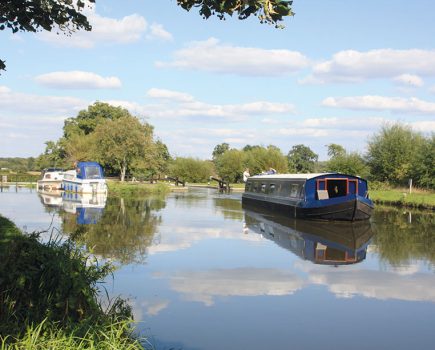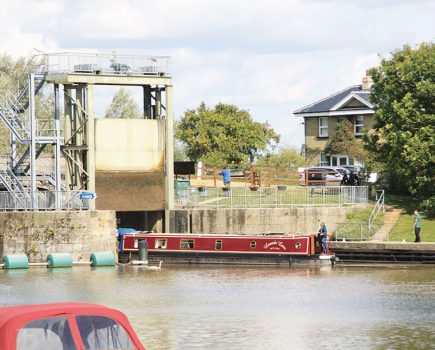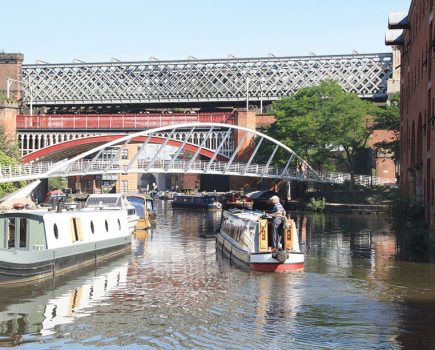After retiring last year, Neil set out on an extended cruise to realise one of his dreams – reaching the city of York by boat. How would he get on with the tidel cruise?

Words and pictures: Neil Barnett
It’s been three years now. Three years since we took the plunge and bought our own boat, having hired over the last 30 years and had a 12th share in one for four years. Regrets? Absolutely none.
Our bank account regularly suffers a hammering now we have to keep and maintain our beloved craft, and I can now understand why folk were always telling me that boat stood for ‘Bring Out Another Thousand’, but we wouldn’t change things for the world.

Six months after purchasing the boat, we moved aboard to live on it. We’d gone for the cheaper and older option as it enabled us to keep the house with tenants in, with the plan that the rental income could help us to retire a little early.
Not having to hand back the boat after a week or two is wonderful, and it’s still a novelty being able go out on it whenever we wish, even if it’s just a short trip up the canal to the pub.
We’ve hired some fine boats over the years and have thoroughly enjoyed our explorations of the network. But for us, we love how we can now do some extended cruising without having to worry about the deadline of returning the boat, or just being able to moor somewhere for a few days or longer.

This was really brought home last summer when, after having recently retired, we embarked on our first proper extended cruise. I’d always wanted to visit York by boat and now was our chance.
It would mean our first venture on tidal waters, something I was quite apprehensive about, and, I wanted to make sure our boat was well prepared now we no longer had the back up from a hire company. I carried out a thorough service, checked everything was in good order, and had somebody in to have the fuel polished (cleaned).
So began our journey from our base near Fradley Junction. After the tranquil Trent & Mersey Canal we reached Nottingham, and preapred for our long journey down the River Trent.

We reached the huge Cromwell Lock and the beginning of the tidal section. Leaving the lock with five other boats, the lockie had told us it would take three hours to reach Torksey, the next proper ‘safe’ moorings.
We were the first to exit on to the river, but straight away the other boats overtook us, and soon disappeared into the distance ahead of us.
Despite our engine running at 2,000rpm, we were travelling considerably slower and, after 20 minutes, the engine temperature rose sharply, right up to its maximum and would have gone higher had I not eased down to 1800rpm. We eventually arrived at Torksey an hour after the other boats.

For the next leg to West Stockwith, and the beginning of the Chesterfield Canal, it was the same slow progress and, after the difficult turn into the lock, we were relieved to be spending the next week or so on calm waters once again.
We ended up spending ten days on this enchanting canal. It really is a gem and such a shame it is so underused.
Mainly rural, I would describe it as pretty without being spectacular. I think folk are put off by the difficult turn into the lock from the river, but it isn’t that bad. I managed it without a hitch but even if I hadn’t done, the worst that would happen is just a scraping of the bows against the lock entrance wall. It’s nothing a coat of blacking wouldn’t fix, so why do people worry so much about it?

Another misconception is the shortage of moorings on this canal but we found plenty, especially if you’re happy to moor in quiet rural places.
After this thoroughly enjoyable diversion, we returned to the Trent and our next leg downstream to Keadby and the beginning of the huge South Yorkshire Navigation canals. About five times wider than most canals and with their long straight stretches, we found the many swing and lift-bridges, all electronically operated, helped break the monotony of what we thought was a mainly flat and featureless landscape.
It was, therefore, a huge contrast when we turned on to the narrower River Aire with its twists and turns snaking its way for the six miles to join the Selby Canal.

After overnighting in Selby we descended on to the River Ouse for the final leg of our journey upstream to York. Once again, with the fast flowing current, our overheating problems returned despite the benefit of the flow of the tide as far as Naburn Lock, which was such a delightful place we stayed there for a few days.
And so to the final few miles of our journey to York, this time without the benefit of the tide. While at Naburn, the river had risen 3ft and the subsequent faster current was noticeable. At times it was difficult to tell if we were moving. I was concerned if the flow increased, we could be in difficulties, especially as the safe haven of moorings were few and far between.
I didn’t dare increase the revs for fear of overheating the engine to the extent that it would pack up – then we would really have been in trouble.

So it was with great relief when we reached Millennium Bridge on the outskirts of York and, soon afterwards, the moorings adjacent to Museum Gardens. We’d finally reached our ultimate destination and we had a thoroughly enjoyable week there despite the nagging worry of whether the boat would manage the journey back home.
York is a wonderful place to visit, especially by boat, although for a river so renowned for its dramatic rise and falls, its disappointing they don’t have any floating mooring pontoons. During our time there, the river level rose 2ft and dropped 4ft so there was always the concern about adjusting the mooring ropes.
Returning to our base in the Midlands, we retraced our outward journey. This time, however, we turned off the Trent at Torksey for the short journey to Lincoln, which was well worth the 11-mile detour.
The engine problems continued but ‘nursing’ it – helped by not having any time constraints – we managed to make it to our home moorings.
Owning our own boat has been marvellous but our mechanical problems do emphasise how it can come with a significant downside, too. I’ve now discovered the high revs needed are normal for my engine and that the overheating issues are common for my make of hull, so I’ve had to part with another £1,000 plus to have an additional skin tank fitted to cure the problem.
Thank you Neil for sending in your story.
Now it’s your turn to tell us about the boats in your life. If you would like to be featured in Me & My Boats in a future issue of Canal Boat magazine, send your story (about 1,000 words) and photographs (don’t worry, we’ll return them!) to editor@canalboat.co.uk. If it’s used, you’ll also win £100!
Image(s) provided by:
Archant







